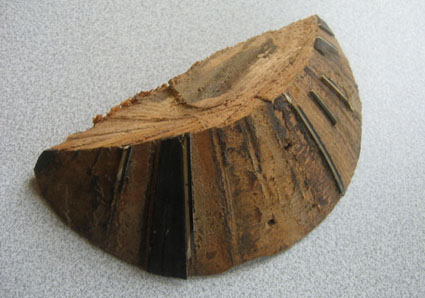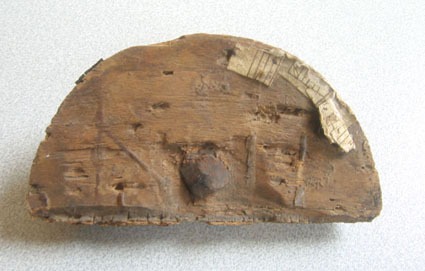

When we received this lute to be restored, it had been reassembled as a 6-string guitar, probably in the early 19th century. The long, slender theorbo neck had been replaced by a short 6-string neck with an anchorpin hole. The back of the neck carried the same inlaid purfling as the original lute shell that was fortunately intact, as was the original neck.


The owner of the instrument asked us to reproduce a neck and headstock to recreate the original technical features, its look and feel, and with luck create a playable instrument. Painstaking research into all the Sellas lutes available worldwide led us to the lute held at Paris Museum under reference 1028, not only a very similar model to ours but a lute which, incredible as it may seem, also dated from the same year -1638. We therefore created a neck and 28-peg pegbox but without etching the ivory-inlayed frets of the fingerboard. Despite the fact that the soundboard was not original and had already been altered at some point, the instrument was, on the whole, in relatively healthy condition, able to tolerate the retightening of the strings. The bridge was of course copied from the 1028 model once all traces of the guitar bridge had been removed, and we delivered the archluth in perfect working order to the satisfied customer, who thanked us profusely.
A few weeks later on, a friend put us onto a complete archluth neck in ebony and ivory, boasting a full set of original pegs, and whose engraved fingerboard gave both the name of the craftsman and the date of manufacture:
Matteo Sellas, Venice, 1638.

This was a truly mind-boggling coincidence, since it was not as if by some strange set of circumstances we had laid our hands on the original neck to the very theorbo that we had been working on, but not before it had been converted… a neck that would have lived on as an erstwhile museum piece. No, we had indeed stumbled upon another neck from the same luthier and made in the same year!
The original shell, built of alternating maple and ivory ribs, was complete, as was the headblock that carried the guitar neck. The newly-discovered neck also had its original headblock with the distinctive clout, as well as a few pieces of the ebony and ivory ribs and inlays from the original shell that, alas, has disappeared.
This was an extraordinary opportunity for the owner of the instrument, who purchased the new neck and commissioned us to remount it on his instrument. We therefore disassembled our reproduction neck, and remounted this magnificent neck with its engraved frets signed Matteo Sellas onto the matching lute shell carrying an inside label dated from the very same year.
When the Paris Museum later acquired the instrument in 1994, we were able to donate the guitar neck together with the original headblock of the second neck that had remained in our possession.


This fascinating, almost unbelievable anecdote is a perfect illustration of the detective work often required of restorers and experts alike in unraveling the history of adjustments and reassemblies that mark the life of a musical instrument.
This archlute is now exhibited at the Paris Music Museum, under reference number E.994.7.1. It is described as follows:
“8x2 strings small set, 6x2 strings long set,
15-rib back in ebony with ivory strips,
sprucewood soundtable ,
sculpted rosette,
veneered ebony neck with ivory marquetry,
fingerboard featuring three engraved ivory inlays depicting war scenes,
signature inside the shell: Matteo Sellas alla Corona In Venitia 1638.
Source: Museum inventory”.
http://mediatheque.cite-musique.fr/masc/default.asp?URL=http://mediatheque.cite-
musique.fr/clientbooklineCIMU/toolkit/p_requests/default-collection-musee.htm
Nota-bene.
Since 2004, the application of the "laws regulating the Museums" has obligated the French museums to hire – for the restoration of objects kept in public collections – "habilitated" restorers. By these terms, we intend persons who have received the State diploma delivered by the Institute for the National Patrimony. This diploma covers all kinds of techniques and materials, but neither expertise of musical instruments nor lutherie or acoustics are taken in consideration on the cursus. From now on, only the "habilitated" restorer for "wood" (all the woods from all over the world?) is qualified to restore objects of the patrimony kept in our national collections and can equally treat beams or floors, furnitures or boats, statues and musical instruments as long as this person has the "habilitation". Therefore, a polemic has started between the museum curators who, realizing their incompetence in the field of lutherie wish to keep the historic instruments only for their visual and cultural aspect and the luthier who consider that the sound of an instrument, being its own specificity and identity, must be restored on the same level as the box that produces it.
Professionals who have – long before the title of "curator" was invented – analyzed, expertised, constructed and restored musical instruments (by countries and by categories: wind, stringed, keyboards, brass, etc.) find themselves put aside from the French public collections.
The "habilitation" for a non universitarian being almost impossible to obtain, these professionals have to apply their art to private collections.
Read: “Habilitation-restaurateur-des-musees.com” (in French).

